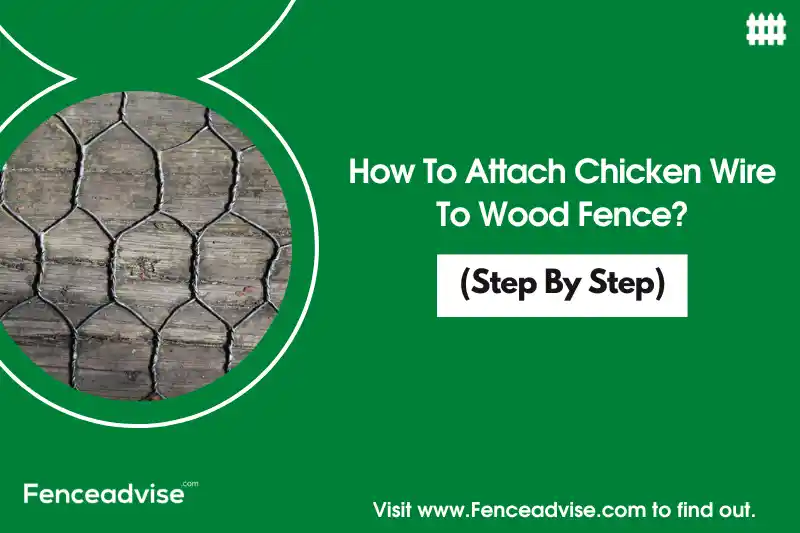We include products we think are useful for our readers. If you buy through links on this page, we may earn a small commission. Read our affiliate disclaimer here.
If you have a wood fence and want to add an extra layer of protection or containment, attaching chicken wire can be a practical solution. Whether you’re looking to keep small animals out of your garden or prevent your pets from escaping, learning how to properly attach chicken wire to a wood fence is essential.
In this article, we will walk you through the step-by-step process, providing you with the knowledge and techniques needed to securely attach chicken wire to your wood fence. Let’s explore how you can enhance the functionality and versatility of your fence with this simple addition.
Key Takeaways
Our Pick
Chicken Wire Fencing Mesh
Experience exceptional flexibility, perfect for wood fences. Its galvanized construction ensures strength and durability, while the 0.6 x 1-inch hexagonal mesh openings prevent small poultry from entering or escaping. Rust protection and easy installation with included accessories make it a versatile choice for various applications, from pet containment to creative DIY projects.
Can Chicken Wire Be Attached To Wood?
Yes, chicken wire can be securely attached to wood surfaces. Chicken wire, also known as poultry netting, is a versatile mesh material commonly used for fencing and protection.
When it comes to attaching chicken wire to wood, there are several effective methods to ensure a secure and durable installation.
These methods typically involve using staples, nails, screws, or zip ties to affix the chicken wire to the wood surface, providing a reliable barrier for containing animals, preventing intrusions, or safeguarding your garden.
By employing the appropriate tools and techniques, you can easily attach chicken wire to your wood fence and enjoy the added benefits of enhanced security and protection.
How To Attach Chicken Wire To Wood Fence?
With a few simple tools and techniques, you’ll be able to secure the wire firmly and ensure a durable installation.
Step 1: Gather the Necessary Materials
Before starting, gather all the materials you’ll need for the project. This typically includes chicken wire, wire cutters, a staple gun or nails, a hammer, gloves, and safety goggles. Ensure you have the appropriate size and length of chicken wire to cover the desired area of your wood fence.
Step 2: Prepare the Wood Fence
Inspect your wood fence for any loose or damaged boards. If necessary, repair or replace any sections that may compromise the stability of the fence. Make sure the surface is clean and free from debris, ensuring better adherence of the chicken wire.
Step 3: Measure and Cut the Chicken Wire
Measure the length of the wood fence section you intend to cover with chicken wire. Use wire cutters to cut the chicken wire to the appropriate size, allowing a few inches of overlap on each side for secure attachment.
Step 4: Attach the Chicken Wire
Start by securing one end of the chicken wire to the wood fence using staples, nails, or screws. Place the fasteners approximately every 6-8 inches along the edges and in the center to ensure a secure attachment. Make sure to pull the wire tightly as you go to prevent sagging or gaps.
Step 5: Continue Attaching the Chicken Wire
Work your way along the wood fence, attaching the chicken wire section by section. Pull the wire tightly and fasten it securely, maintaining an even and taut installation. Take care to overlap each piece of chicken wire slightly to maintain a continuous barrier.
Step 6: Trim Excess Wire
Once you have attached the chicken wire along the entire length of the wood fence, trim any excess wire using wire cutters. Be cautious while cutting and wear gloves to protect your hands from sharp edges.
Step 7: Secure Loose Ends
To ensure a neat and tidy finish, secure any loose ends or protruding wires by folding them back or twisting them around the fence structure. This step will prevent any potential hazards and enhance the overall appearance of the installation.
Step 8: Inspect and Test
Carefully inspect the attached chicken wire to ensure it is securely fastened and there are no gaps or areas that may allow animals to pass through. Give the wire a gentle tug to test its strength and stability. Make any necessary adjustments or reinforcements to ensure a solid and reliable installation.
By following these step-by-step instructions, you can effectively attach chicken wire to your wood fence and create a secure barrier. This simple yet effective solution will help protect your property, plants, and animals, providing peace of mind and maintaining a well-defined boundary.
Best Chicken Wire To Attach To Wood Fence
Chicken Wire Fencing Mesh- Fabulas
Our Pick
Chicken Wire Fencing Mesh
Experience exceptional flexibility with our chicken wire mesh, perfect for wood fences. Its galvanized construction ensures strength and durability, while the 0.6 x 1-inch hexagonal mesh openings prevent small poultry from entering or escaping. Rust protection and easy installation with included accessories make it a versatile choice for various applications, from pet containment to creative DIY projects.
Its galvanized construction ensures strength and durability, surpassing nylon or plastic alternatives. Whether you’re looking to reinforce an existing wood fence or create a new enclosure, this chicken wire mesh is a reliable choice.
The 16.9 inches x 32.8 feet dimensions of this mesh make it suitable for covering extensive sections of a wood fence. Its soft and flexible yet strong galvanized design allows for easy cutting and bending to fit your specific needs. Additionally, the mesh can be seamlessly joined together if the height is insufficient for your fence, ensuring a secure and cohesive attachment.
One of the key benefits of this chicken wire mesh is its double hot-dip galvanization, providing maximum rust protection and a longer lifespan. The double-twist hexagonal design enhances its durability, making it less likely to break or deform over time. With this mesh, you can have peace of mind knowing that your wood fence is safeguarded against potential damage.
The small 0.6 x 1-inch hexagonal mesh openings are designed to prevent poultry, including small chicks, from entering or escaping through the fence. The thickened wire with a diameter of 0.6mm ensures the mesh’s strength and longevity. Despite its sturdy construction, the evenly distributed grid allows for easy cutting and forming while maintaining unobstructed visibility through the fence.
Beyond poultry containment, it effectively keeps out unwanted animals such as squirrels, rabbits, raccoons, and skunks. You can even utilize it as a floral chicken wire for garden fencing, protecting your precious plants from cats, dogs, and other pets.
Craft fruit baskets, pet cage safes, Christmas wreath frames, photo walls, and more can be effortlessly made using this chicken wire mesh. Let your imagination run wild and explore the endless crafting opportunities it offers.
Additionally, a pair of nitrile gloves are provided for hand protection, and mini industrial-grade wire pliers assist in easy cutting. The roll of 10m wire is essential for splicing hardware cloth pieces together, ensuring a secure and sturdy attachment to your wood fence.
What We Like:
- Easy installation: Cuttable and splicable properties for quick and flexible attachment to a wood fence.
- Durability: Galvanized construction ensures long-lasting performance and protection.
- Versatile application: Suitable for various uses, including poultry containment, garden fencing, and DIY projects.
- Visual appeal: Maintains visibility and blends well with the surroundings for an attractive fence appearance.
Factors to Consider:
- Compatibility: Check dimensions, gauge, and mesh size to ensure proper fit with your wood fence.
- Security level: Evaluate if additional reinforcement is needed based on potential intruders’ size and strength.
- Maintenance: Regular cleaning, rust prevention, and repairs may be necessary for optimal performance.
- Local regulations: Familiarize yourself with any rules or guidelines regarding fencing materials in your area.
fence advise editor’s choice
Chicken Wire Fencing Mesh
Chicken Wire Fasteners
Staples or U-shaped nails are commonly used as the best chicken wire fasteners for attaching to a wood fence. These fasteners provide a secure and reliable connection, ensuring that the chicken wire stays in place and effectively covers the fence.
Best Recommended Chicken Wire Fastener for Wood Fence
OMOTOOL Steel Wire Fencing Staples
When it comes to securing wire fencing and woven applications, having the right fasteners is crucial for a sturdy and reliable installation. The Steel Fencing Staples package offers a convenient solution with its 200 pieces of high-quality staples.
These staples are designed to meet your daily needs and provide a secure attachment for various types of materials, including wood, drywall, concrete walls, brick, plaster, and pine.
Made of Q195 carbon steel, they are exceptionally hard and sharp, ensuring they stay straight when hammered in. This durability allows them to withstand the rigors of installation without bending or breaking, providing a reliable hold for your wire fencing projects.
They can be used in a wide range of applications, making them a versatile choice for different types of projects. Whether you’re installing livestock fences, field fences, horse fencing, chain link fences, or even pole copper ground wires, these staples are up to the task. Their sturdy build and sharp tips ensure a secure attachment that can withstand the demands of outdoor environments.
Furthermore, the galvanized surface of these staples adds an extra layer of protection. Galvanization is a process that applies a protective zinc coating to the staples, effectively preventing corrosion. This is especially important for outdoor applications where the staples may be exposed to moisture, humidity, or other environmental factors. The galvanized surface helps to prolong the lifespan of the staples, ensuring their reliability and performance over time.
In terms of dimensions, these staples have a wire diameter of approximately 2.3mm, a length of 25mm, and a width of 14mm. These measurements make them suitable for a variety of wire fencing and woven applications, providing a secure and robust attachment.
Overall, the Steel Fencing Staples offers a reliable and practical solution for securing wire fences and other installations. With their high-quality construction, sharpness, versatility, and galvanized surface, these staples provide a durable and corrosion-resistant fastening option.
Conclusion
In conclusion, attaching chicken wire to a wood fence can provide added protection and containment for your property. By following the step-by-step instructions, you can easily secure chicken wire to your wood fence using staples, nails, screws, or zip ties.
The recommended Chicken Wire Fencing Mesh offers exceptional flexibility, durability, and versatility for attaching to a wood fence. Additionally, the OMOTOOL Steel Wire Fencing Staples provides a reliable and secure fastening option.
Consider factors such as compatibility, security level, maintenance, and local regulations when attaching chicken wire to your wood fence. With the right materials and techniques, you can create a secure barrier that safeguards your property, plants, and animals.
At FenceAdvise, we pride ourselves on being the most reliable and trustworthy source of fencing information. Our articles are based on only the highest quality sources, including peer-reviewed studies, to ensure that our readers always have access to accurate information. Read more about our Editorial Guidelines, About Us.










